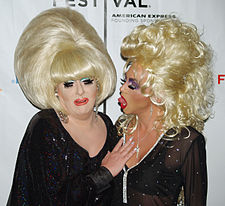History of cross-dressing
CW-en.wikipedia.org
Cross-dressing has been practiced throughout much of recorded history and in many societies. There are many examples in Greek,Norse, and Hindu mythology. A reasonable number of historical figures are known to have cross-dressed to varying degrees and for a variety of reasons. There is a rich history of cross-dressing found in folklore, literature, theater, and music. Examples includeKabuki and Korean shamanism.
Varieties
There are many different kinds of cross-dressing and many different reasons why an individual might engage in cross-dressing behavior.[2] Some people cross-dress as a matter of comfort or style, out of personal preference for clothing associated with the opposite sex. In this case, a person's cross-dressing may or may not be apparent to other people. Some people cross-dress to shock others or challenge social norms.
Gender disguise has been used by women and girls to pass as male in society and by men and boys to pass themselves off as female. Gender disguise has also been used as a plot device in storytelling and is a recurring motif in literature, theater, and film. It is a common plot device in narrative ballads.[3] Historically, some women have cross-dressed to take up male-dominated or male-exclusive professions, such as military service. Conversely, some men have cross-dressed to escape from mandatory military service[4] or as a disguise to assist in political or social protest, as men did in the Rebecca Riots.
Single-sex theatrical troupes often have some performers who cross-dress to play roles written for members of the opposite sex (travesti). Cross-dressing, particularly the depiction of males wearing dresses, is often used for comic effect onstage and onscreen.
Drag is a special form of performance art based on the act of cross-dressing. A drag queen is usually a male-bodied person who performs as an exaggeratedly feminine character, in heightened costuming sometimes consisting of a showy dress, high-heeled shoes, obvious makeup, and wig. A drag queen may imitate famous female film or pop-music stars. A faux queen is a female-bodied person employing the same techniques.
A drag king is a counterpart of the drag queen but usually for much different audiences, and is defined as a female-bodied person who adopts a masculine persona in performance or imitates a male film or pop-music star. Some female-bodied people undergoing gender reassignment therapy also self-identify as drag kings although this use of "drag king" would generally be considered inaccurate.
A transvestic fetishist is a person (typically a heterosexual male) who cross-dresses as part of asexual fetish.
The term underdressing is used by male cross-dressers to describe wearing female undergarments under their male clothes. The famous low-budget filmmaker Edward D. Wood, Jr.said he often wore women's underwear under his military uniform during World War II.
Some people who cross-dress may endeavor to project a complete impression of belonging to another gender, including mannerisms, speech patterns, and emulation of sexual characteristics. This is referred to as passing or "trying to pass" depending how successful the person is. An observer who sees through the cross-dresser's attempt to pass is said to have reador clocked them. There are videos, books, and magazines on how a man may look more like a woman.[5]
Sometimes either member of a heterosexual couple will crossdress in order to arouse the other. For example, the male might wear skirts or lingerie and/or the female will wear boxers or other male clothing. (See also forced feminization)
Others may choose to take a mixed approach, adopting some feminine traits and some masculine traits in their appearance. For instance, a man might wear both a dress and a beard. This is sometimes known as genderfuck.



No comments:
Post a Comment